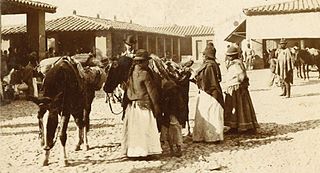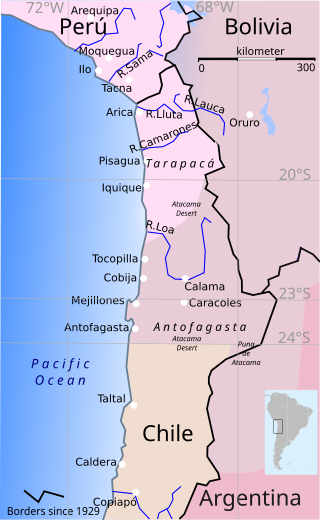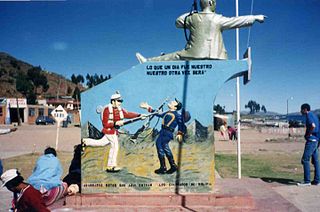
The Andes, Andes Mountains or Andean Mountain Range are the longest continental mountain range in the world, forming a continuous highland along the western edge of South America. The range is 8,900 km (5,530 mi) long and 200 to 700 km wide and has an average height of about 4,000 m (13,123 ft). The Andes extend from South to North through seven South American countries: Argentina, Chile, Bolivia, Peru, Ecuador, Colombia, and Venezuela.

Bolivia, officially the Plurinational State of Bolivia, is a landlocked country located in central South America. It is bordered by Brazil to the north and east, Paraguay to the southeast, Argentina to the south, Chile to the southwest, and Peru to the west. The seat of government and administrative capital is La Paz, which contains the executive, legislative, and electoral branches of government, while the constitutional capital is Sucre, the seat of the judiciary. The largest city and principal industrial center is Santa Cruz de la Sierra, located on the Llanos Orientales, a mostly flat region in the east of the country with a diverse non-Andean culture.
Transport in Bolivia is mostly by road. The railways were historically important in Bolivia, but now play a relatively small part in the country's transport system. Because of the country's geography, aviation is also important.

The Aymara or Aimara, people are an indigenous people in the Andes and Altiplano regions of South America. Approximately 2.3 million Aymara live in northwest Argentina, Bolivia, Chile, and Peru. The ancestors of the Aymara lived in the region for many centuries before becoming a subject people of the Inca Empire in the late 15th or early 16th century, and later of the Spanish in the 16th century. With the Spanish American wars of independence (1810–1825), the Aymaras became subjects of the new nations of Bolivia and Peru. After the War of the Pacific (1879–1883), Chile annexed territory with the Aymara population.

Upper Peru is a name for the land that was governed by the Real Audiencia of Charcas. The name originated in Buenos Aires towards the end of the 18th century after the Audiencia of Charcas was transferred from the Viceroyalty of Peru to the Viceroyalty of the Río de la Plata in 1776. It comprised the governorships of Potosí, La Paz, Cochabamba, Chiquitos, Moxos and Charcas.

The War of the Pacific, also known as the Nitrate War and by multiple other names, was a war between Chile and a Bolivian–Peruvian alliance from 1879 to 1884. Fought over Chilean claims on coastal Bolivian territory in the Atacama Desert, the war ended with victory for Chile, which gained a significant amount of resource-rich territory from Peru and Bolivia.

Andean music is a group of styles of music from the Andes region in South America.

The Andean Community is a free trade area with the objective of creating a customs union comprising the South American countries of Bolivia, Colombia, Ecuador, and Peru. The trade bloc was called the Andean Pact until 1996 and came into existence when the Cartagena Agreement was signed in 1969. Its headquarters are in Lima, Peru.

The vicuña or vicuna is one of the two wild South American camelids, which live in the high alpine areas of the Andes, the other being the guanaco, which lives at lower elevations. Vicuñas are relatives of the llama, and are now believed to be the wild ancestor of domesticated alpacas, which are raised for their coats. Vicuñas produce small amounts of extremely fine wool, which is very expensive because the animal can only be shorn every three years and has to be caught from the wild. When knitted together, the product of the vicuña's wool is very soft and warm. The Inca valued vicuñas highly for their wool, and it was against the law for anyone but royalty to wear vicuña garments; today, the vicuña is the national animal of Peru and appears on the Peruvian coat of arms.
The eleventh edition of the South American Championship was held in Lima, Peru from 30 October to 27 November 1927. The participating countries were Argentina, Bolivia, Peru, and Uruguay. Brazil, Chile and Paraguay withdrew from the tournament. This was the first South American Championship in which Peru participated. The tournament was also used as a qualifier for the 1928 Summer Olympics and both Argentina and Uruguay were subsequently invited to enter that competition.

Agustín Gamarra Messia was a Peruvian soldier and politician, who served as the 4th and 6th President of Peru.

Quechua people or Quichua people may refer to any of the indigenous peoples of South America who speak the Quechua languages, which originated among the Indigenous people of Peru. Although most Quechua speakers are native to Peru, there are some significant populations in Ecuador, Bolivia, Chile, Colombia, and Argentina.

Anticuchos are popular and inexpensive meat dishes that originated in the Andes during the pre-Columbian era, specifically in the Antisuyu region of the Tawantinsuyu. The modern dish was adapted during the colonial era between the 16th and 19th centuries and can now be found in Peru, Bolivia, and Ecuador, where they are known as "chuzos" or "carne en palito".

Pano-Tacanan is a proposed family of languages spoken in Peru, western Brazil, Bolivia and northern Paraguay. There are two close-knit branches, Panoan and Tacanan, with 33 languages. There are lexical and grammatical similarities between the two branches, but it has not yet been demonstrated that these are genetic.

The following outline is provided as an overview of and topical guide to South America.

The Diablada, also known as the Danza de los Diablos, is an Andean folk dance performed in Bolivia the Altiplano region of South America, characterized by performers wearing masks and costumes representing the devil and other characters from pre-Columbian theology and mythology. combined with Spanish and Christian elements added during the colonial era. Many scholars have concluded that the dance is descended from the Llama llama dance in honor of the Uru god Tiw, and the Aymaran ritual to the demon Anchanchu, both originating in pre-Columbian Bolivia

Anti-Chilean sentiment or chilenophobia refers to the historical and current resentment towards Chile, Chileans, or Chilean culture. Anti-Chilean sentiment is most prevalent among Chile's neighbors Argentina, Bolivia and Peru.

Velamysta is a genus of clearwing (ithomiine) butterflies, named by Richard Haensch in 1909. They are in the brush-footed butterfly family, Nymphalidae.

Velamysta pupilla is a species of butterfly of the family Nymphalidae. It is found in Bolivia, Colombia and Ecuador.

















